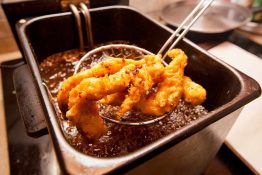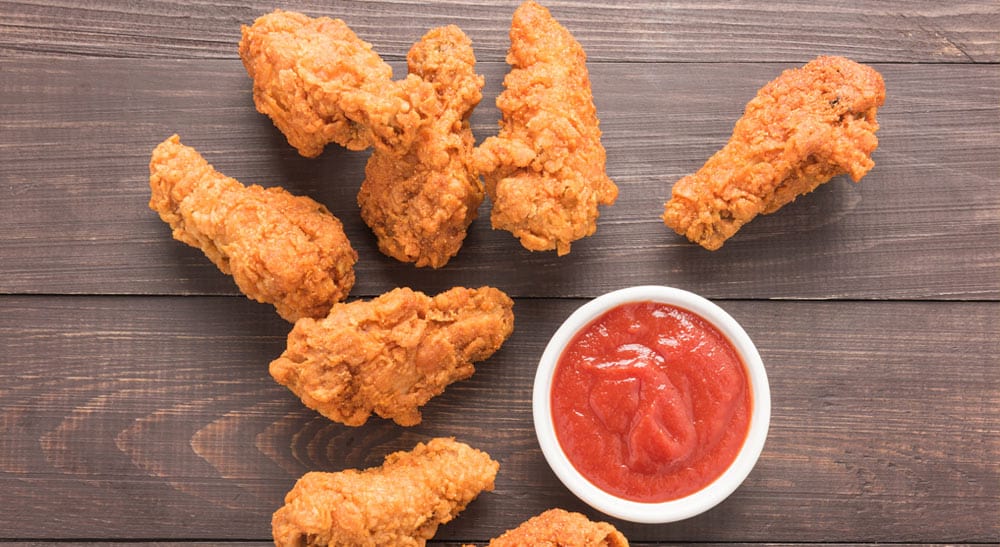By Harriet Mallinson | Published on July 25, 2017
Deep fried chicken is one of life’s true pleasures. It hits the spot like nothing else at the local fast food joint after a big night out and it’s just as perfect when homemade for lunch.
But what exactly happens when we deep fry chicken and how can we do it best in our own kitchens?
A handy video produced by the American Chemical Society and PBS Digital Studios has revealed the science behind one of our favorite crispy treats.
What do you do first?
First marinate and batter the chicken before selecting either a deep fat fryer or a deep, ideally cast iron, skillet. For a cooking oil, canola, vegetable and peanut oil work best as they have a neural flavor and can reach high temperatures without smoking.
You can add antioxidant-rich spinach powder or ginseng extract to your batter to make it that little bit more nutritious, but unfortunately, it’s the oil part of cooking fried chicken that makes the meal unavoidably unhealthy.
All cooking oils are filled with triglycerides – big molecules made up of glycerol and free fatty acid chains – which are the main component of human body fat.
What happens when the frying begins?
When the chicken is dunked into oil – which should be piping hot at 150-190°C –  hotter/less dense oil rises while colder/denser oil sinks to the bottom of the vat, creating a constant even circulation of heat at the surface of your chicken. This then diffuses into the center of the chicken to cook the raw meat.
In a few seconds, bubbles will be sizzling at the edge of the meat which, rather than coming from the boiling oil as you might think, are actually made from steam from the boiled water leaving the meat. These rapid-fire bubbles create an important steam barrier that then blocks the chicken from absorbing too much oil which helps maintain the crispy crunch we know and love.
At this point in the cooking process, three important chemical processes are underway: hydrolysis, oxidation and polymerization.

The chemical process
Hydrolysis
Hydrolysis occurs when a compound is split into fragments by water. In this case, the water released from the chicken reacts with the triglycerides in the frying oil, splitting them into free fatty acids and other compounds. It might sound far from tasty, but this process is crucial in extracting water from fried foods and gives the battered skin on the chicken an amazing texture.
Always be sure to refresh your oil if you notice foaming, smoking, deeper color oil or the musty fishy smell of free fatty acids which build up in the frying oil as hydrolysis slows down. Changing your oil will prevent any unpleasant flavors and odors.
– RELATED: Which Oil Should You Use In The Kitchen? –
Oxidation
This occurs when oxygen reacts with oil during the deep-frying process – get it right and the gently browned fried chicken will have a pleasant buttery, nutty flavor, get it wrong and your chicken will be robbed of good flavors in exchange for a fishy scent. This occurs when the oxidation of certain fatty acids like linoleic acid produce volatile (and smelly) compounds which can easily go airborne and fly into your nostrils.
To avoid this, use for a deep fat fryer or a deep pot which have a small surface area to volume ratio to cook the chicken in. With the meat totally submerged in the oil, less oxygen will reach the goods thereby allowing for fewer unsavory reactions.
Polymerization
Polymerization takes place when high heat causes fatty acids to form longer chains of fat, known as polymers. This process speeds up the degradation of oil, making it thicker and consequently ruining the taste of the chicken.
Higher temperatures speed up both oxidation and polymerization so use a thermometer and make sure the oil temperature stays close to 168°C; it’s important the temperature stays consistent throughout the frying.
Also take care to watch how long you fry the chicken for; under-fried will lack color and crunch and may not cook through, while over-fried chicken will be too tough, ugly and greasy.
The chicken will be done when very few bubbles are left on the meat’s surface. Fish them out before excess oil seeps in, let them cool out on a rack… and feast!
Harriet is Editor of MACROS and perfectly capable of eating an entire log of goat’s cheese in one sitting.

